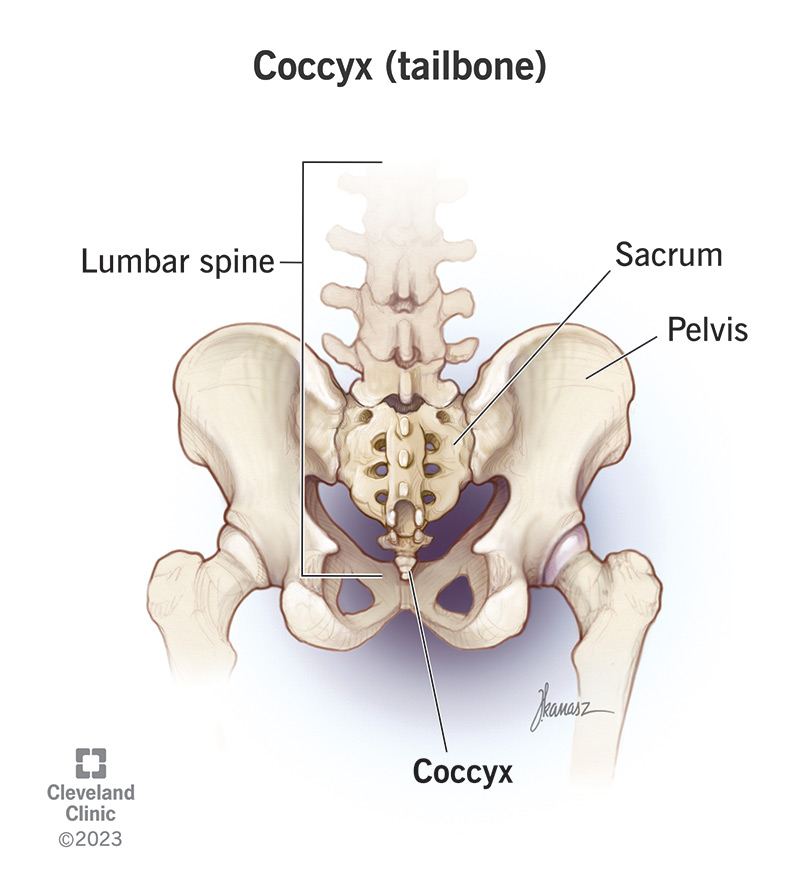The coccyx is the last bone at the bottom (base) of your spine. It’s a small, curved bone that’s made of between three and five vertebrae fused together. Most people know the coccyx as the tailbone. It supports your weight and helps you keep your balance when you’re sitting down. Tailbone pain and injuries are common, especially after falls.

The coccyx is the last bone at the bottom (base) of your spine. It’s a small, curved bone that you may never think about — until you slip and fall on it. Even when you’re not aware of it, your coccyx helps support your body and connect important muscles and ligaments. The coccyx is also called the tailbone.
The tailbone gets its name from what it used to be. It’s a remnant of the tail we used to have. Humans evolved not to have tails a long time ago. The coccyx is a vestigial piece of your body — part of our anatomy that isn’t necessary for us to survive, like evolutionary leftovers from our past.
Visit a healthcare provider if you’re having tailbone pain, especially if your coccyx hurts after a slip, fall or sports injury.
Yes, coccyx and tailbone are different names for the same bone. Most people know it as the tailbone — coccyx is the medical name healthcare providers use.
Advertisement
Cleveland Clinic is a non-profit academic medical center. Advertising on our site helps support our mission. We do not endorse non-Cleveland Clinic products or services. Policy
Your bones are your body’s support structure. They support your weight and anchor other types of tissue throughout your body.
The coccyx is like one leg of a tripod that evenly distributes your weight to keep you stable when sitting down. It works with the pointed sections of your pelvis (the ischial spines) to support your body weight when you’re sitting.
Your tailbone is an anchor for muscles, including your:
Your coccyx also supports tendons and ligaments that connect to other structures around it. Several nerves connected to your coccyx give it (and the area around it) feeling.
The coccyx is the last bone in your spine, the bone furthest away from your head. It’s right below your sacrum — the final part of your lumbar spine in your lower back.
Advertisement
The coccyx is usually referred to as a single bone, but it’s actually several vertebrae (the plural form of vertebra) fused together. Vertebrae are the linked bones that make up your spinal column.
Tailbones are usually made of four fused vertebrae, but people can have anywhere from three to five.
Injuries like falls or repetitive strain injuries can damage your coccyx. The most common tailbone injury is slipping, falling and landing flat on your butt. These kinds of falls can cause a bone bruise or bone fracture in your coccyx.
You might be more likely to injure your coccyx if you:
It’s very rare, but some types of cancer can damage your coccyx, including:
Your provider might use a few types of imaging tests to take pictures of your coccyx and the area around it, including:
A pain pattern is a term healthcare providers use to describe how pain changes over time. The pain might change depending on the time of day, which position you’re in or which activities you’re doing. Tell your provider if you notice anything that makes the tailbone pain you’re experiencing better or worse. Tell them if it feels like the pain is spreading (radiating) from one area of your body to another.
Advertisement
Some tailbone injuries can get better with minimal (or no) treatment. But you should always visit a healthcare provider if you’re experiencing pain or swelling that doesn’t go away in a few days. Even if you only need at-home treatments to help your tailbone heal, a provider needs to examine the injury and diagnose what’s causing your symptoms.
The sacrum and coccyx are both bones at the bottom (base) of your spine. The sacrum is a triangle-shaped bone between your hip bones. It’s located right above your coccyx. The coccyx is your tailbone at the end of your spine.
The coccyx is your tailbone, the last bone at the end of your spine. Even though it’s such a small bone, it does a big job helping you keep your balance when you’re sitting down. You’ve probably felt tailbone pain if you’ve ever landed on your butt after a slip or fall.
Even though you can treat most cases of tailbone pain at home, don’t ignore pain if it hurts to sit or move in the ways you usually do. Visit a healthcare provider if your coccyx, or the area around it, is painful, especially if you fell or were injured during a sport or other physical activity.
Last reviewed on 01/17/2024.
Learn more about the Health Library and our editorial process.
Advertisement
Cleveland Clinic is a non-profit academic medical center. Advertising on our site helps support our mission. We do not endorse non-Cleveland Clinic products or services. Policy